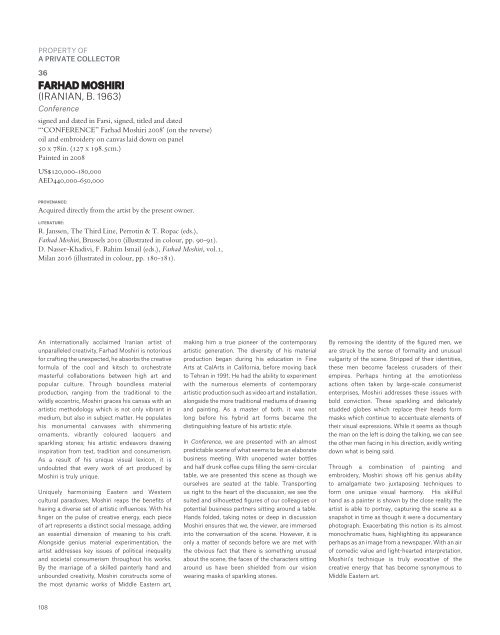NOW AND TEN
DUB1241_SaleCat
DUB1241_SaleCat
Create successful ePaper yourself
Turn your PDF publications into a flip-book with our unique Google optimized e-Paper software.
PROPERTY OF<br />
A PRIVATE COLLECTOR<br />
36<br />
FARHAD MOSHIRI<br />
(IRANIAN, B. 1963)<br />
Conference<br />
signed and dated in Farsi, signed, titled and dated<br />
‘“CONFERENCE” Farhad Moshiri 2008’ (on the reverse)<br />
oil and embroidery on canvas laid down on panel<br />
50 x 78in. (127 x 198.5cm.)<br />
Painted in 2008<br />
US$120,000-180,000<br />
AED440,000-650,000<br />
PROVENANCE:<br />
Acquired directly from the artist by the present owner.<br />
LITERATURE:<br />
R. Janssen, The Third Line, Perrotin & T. Ropac (eds.),<br />
Farhad Moshiri, Brussels 2010 (illustrated in colour, pp. 90-91).<br />
D. Nasser-Khadivi, F. Rahim Ismail (eds.), Farhad Moshiri, vol.1,<br />
Milan 2016 (illustrated in colour, pp. 180-181).<br />
An internationally acclaimed Iranian artist of<br />
unparalleled creativity, Farhad Moshiri is notorious<br />
for crafting the unexpected, he absorbs the creative<br />
formula of the cool and kitsch to orchestrate<br />
masterful collaborations between high art and<br />
popular culture. Through boundless material<br />
production, ranging from the traditional to the<br />
wildly eccentric, Moshiri graces his canvas with an<br />
artistic methodology which is not only vibrant in<br />
medium, but also in subject matter. He populates<br />
his monumental canvases with shimmering<br />
ornaments, vibrantly coloured lacquers and<br />
sparkling stones; his artistic endeavors drawing<br />
inspiration from text, tradition and consumerism.<br />
As a result of his unique visual lexicon, it is<br />
undoubted that every work of art produced by<br />
Moshiri is truly unique.<br />
Uniquely harmonising Eastern and Western<br />
cultural paradoxes, Moshiri reaps the benefts of<br />
having a diverse set of artistic infuences. With his<br />
fnger on the pulse of creative energy, each piece<br />
of art represents a distinct social message, adding<br />
an essential dimension of meaning to his craft.<br />
Alongside genius material experimentation, the<br />
artist addresses key issues of political inequality<br />
and societal consumerism throughout his works.<br />
By the marriage of a skilled painterly hand and<br />
unbounded creativity, Moshiri constructs some of<br />
the most dynamic works of Middle Eastern art,<br />
making him a true pioneer of the contemporary<br />
artistic generation. The diversity of his material<br />
production began during his education in Fine<br />
Arts at CalArts in California, before moving back<br />
to Tehran in 1991. He had the ability to experiment<br />
with the numerous elements of contemporary<br />
artistic production such as video art and installation,<br />
alongside the more traditional mediums of drawing<br />
and painting. As a master of both, it was not<br />
long before his hybrid art forms became the<br />
distinguishing feature of his artistic style.<br />
In Conference, we are presented with an almost<br />
predictable scene of what seems to be an elaborate<br />
business meeting. With unopened water bottles<br />
and half drunk cofee cups flling the semi-circular<br />
table, we are presented this scene as though we<br />
ourselves are seated at the table. Transporting<br />
us right to the heart of the discussion, we see the<br />
suited and silhouetted fgures of our colleagues or<br />
potential business partners sitting around a table.<br />
Hands folded, taking notes or deep in discussion<br />
Moshiri ensures that we, the viewer, are immersed<br />
into the conversation of the scene. However, it is<br />
only a matter of seconds before we are met with<br />
the obvious fact that there is something unusual<br />
about the scene, the faces of the characters sitting<br />
around us have been shielded from our vision<br />
wearing masks of sparkling stones.<br />
By removing the identity of the fgured men, we<br />
are struck by the sense of formality and unusual<br />
vulgarity of the scene. Stripped of their identities,<br />
these men become faceless crusaders of their<br />
empires. Perhaps hinting at the emotionless<br />
actions often taken by large-scale consumerist<br />
enterprises, Moshiri addresses these issues with<br />
bold conviction. These sparkling and delicately<br />
studded globes which replace their heads form<br />
masks which continue to accentuate elements of<br />
their visual expressions. While it seems as though<br />
the man on the left is doing the talking, we can see<br />
the other men facing in his direction, avidly writing<br />
down what is being said.<br />
Through a combination of painting and<br />
embroidery, Moshiri shows of his genius ability<br />
to amalgamate two juxtaposing techniques to<br />
form one unique visual harmony. His skillful<br />
hand as a painter is shown by the close reality the<br />
artist is able to portray, capturing the scene as a<br />
snapshot in time as though it were a documentary<br />
photograph. Exacerbating this notion is its almost<br />
monochromatic hues, highlighting its appearance<br />
perhaps as an image from a newspaper. With an air<br />
of comedic value and light-hearted interpretation,<br />
Moshiri’s technique is truly evocative of the<br />
creative energy that has become synonymous to<br />
Middle Eastern art.<br />
108


